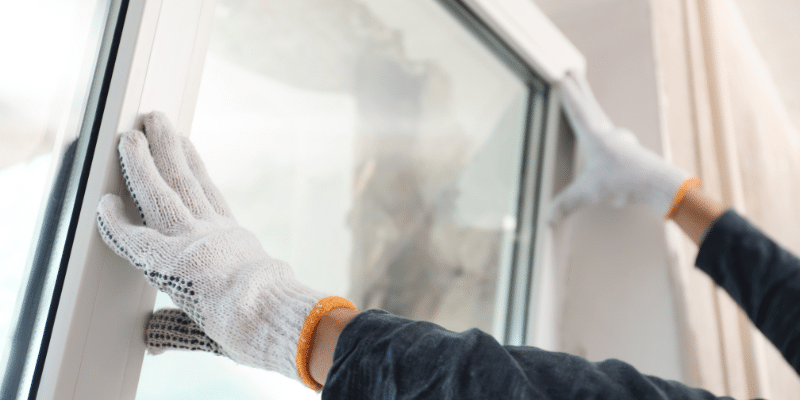Condensation on windows can be a common issue for many homeowners. Whether it’s on the inside, outside, or between the glass panes, understanding the causes and knowing how to prevent it can help maintain the longevity and energy efficiency of your windows.
In this guide, we’ll explore the reasons behind window condensation on three parts of the window and provide practical solutions to manage each type effectively.
Condensation on the Inside of the Window
Interior window condensation typically occurs when warm, moist air inside your home comes in contact with the cooler surface of the glass. This process is similar to how a cold drink forms droplets on a hot day. Here are the primary causes and solutions:
1. Trapped Warm Air
Interior window condensation is often caused by window coverings, such as curtains or blinds, trapping warm air against the cooler window surface. This is particularly common in winter when indoor heating is high.
Solution:
- Ensure that your window coverings allow for adequate air circulation. Consider using blinds that can be tilted to let air flow or curtains that can be drawn back slightly.
2. High Humidity Levels
Activities like cooking, bathing, or having large groups of people in one room can increase indoor humidity. Seasonal changes in spring and fall can also elevate humidity levels inside your home.
Solution:
- Use a dehumidifier to maintain optimal indoor humidity levels (between 30-50%).
- Ventilate areas where moisture is generated, such as kitchens and bathrooms, by using exhaust fans or opening windows.
3. Houseplants
Having many plants near your windows can contribute to higher humidity levels, which may lead to condensation.
Solution:
- Move plants away from windows or reduce the number of plants in your home to decrease humidity.
Condensation on the Outside of the Window
Exterior window condensation is a sign of highly energy-efficient windows, such as triple-glazed windows. This type of condensation occurs under specific weather conditions and is similar to the formation of dew. Here’s what causes it:
1. Energy-Efficient Windows
Homeowners with highly energy-efficient windows may sometimes notice condensation on the outside during late summer and early fall when nighttime temperatures drop significantly.
Solution:
- This type of condensation indicates that your windows are effectively insulating your home. It’s not a problem that requires fixing.
2. Weather Conditions
The moisture on the exterior of windows typically appears in the early morning and is influenced by nighttime temperature drops.
Solution:
- Simply wait for the sun to rise and warm up the glass, causing the condensation to evaporate naturally.
Condensation Between the Glass Panes
If you see moisture between the panes of glass, it indicates a failure in the window seals. This issue requires attention as it affects the insulation properties of your windows.
1. Failed Seals
When the seals between the glass panes fail, moisture can enter the space and cause condensation, indicating that the insulating gas has likely leaked out.
Solution:
- It’s a sign that it’s time to replace your windows. Contact a professional window service to assess and replace the affected windows to restore their efficiency.
2. Cracks in the Glass
Cracks in the glass panes can allow moisture to seep into the space between them and they may be too small to notice at first. This can compromise the structural integrity and insulation properties of the window.
Solution:
- Inspect your windows regularly for any cracks or damage. If cracks are found, it’s important to replace the affected glass panes promptly to prevent further issues.
Window Condensation FAQs
1. Why do I see condensation on my windows only in the winter?
Condensation is more common in winter because the temperature difference between the warm indoor air and the cold outdoor air is greater, causing moisture in the warm air to condense (turn from gas to liquid) on the cold window surface.
2. How can I prevent window condensation in my home?
Maintain proper indoor humidity levels using dehumidifiers, ensure good ventilation, and avoid blocking air circulation around windows with heavy window coverings. Remember, if the condensation is forming on the outside of your windows, then there is nothing you need to fix.
3. Is condensation between window panes a serious issue?
Yes, condensation between panes indicates that the window seals have failed which also reduces the window’s insulating properties. This typically requires window replacement to fix.
4. Can window condensation cause mould?
Yes, prolonged window condensation can lead to mould growth on windowsills and frames. Managing humidity levels and ensuring proper ventilation can prevent mold development.
5. What causes window seals to fail?
Significant temperature fluctuations can cause the materials in the window seals to expand and contract, leading to seal failure over time. Also, age—which is the most common factor. Windows typically last between 20 to 40 years, depending on the material and maintenance, so if you’ve had the same windows for the past two decades, it might be time for an upgrade.
Have more questions about window upgrades? Check out our dedicated FAQ page for customers.
Contact Linton Window and Door for Expert Solutions
If you’re experiencing persistent window condensation issues, it might be time to consult the experts. At Linton Window and Door, we offer professional window assessment and replacement services to ensure your home’s seals are up to par. Contact us today for a free consultation and take the first step towards a condensation-free home.

